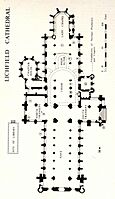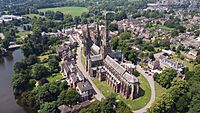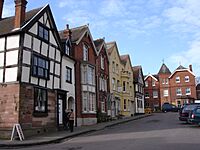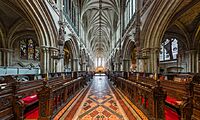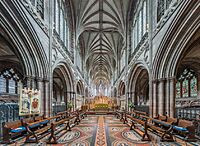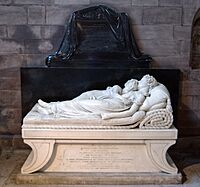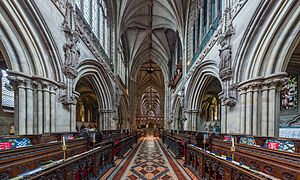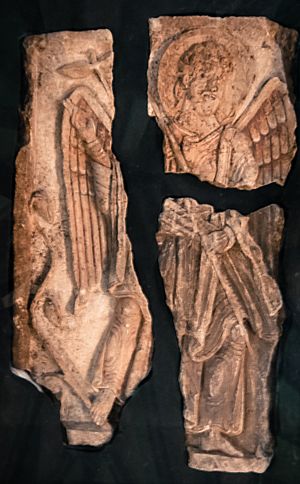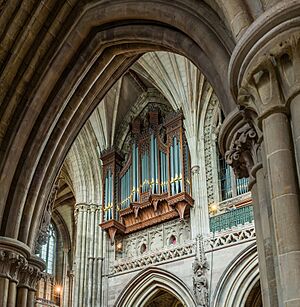Lichfield Cathedral facts for kids
Quick facts for kids Lichfield Cathedral |
|
|---|---|
| Cathedral Church of Saint Mary and Saint Chad | |
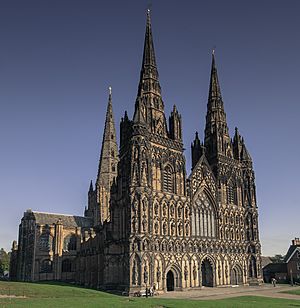
The West Front of Lichfield Cathedral
|
|
| 52°41′08″N 1°49′50″W / 52.6855°N 1.8305°W | |
| Location | Lichfield, Staffordshire |
| Country | England |
| Denomination | Church of England |
| Previous denomination | Roman Catholic |
| Tradition | High church |
| Architecture | |
| Functional status | Cathedral |
| Previous cathedrals | Early Anglo-Saxon and a second cathedral of undetermined date |
| Style | Gothic |
| Years built | early 13th century–1330 |
| Specifications | |
| Length | 113 m (371 ft) |
| Nave width | 21 m (69 ft) |
| Width across transepts | 50 m (160 ft) |
| Height | 76.8 m (252 ft) (central spire) |
| Number of towers | 3 |
| Number of spires | 3 |
| Spire height | 76.8 m (252 ft) (crossing), 60.5 m (198 ft) (western) |
| Administration | |
| Diocese | Lichfield (since 669 – 6th diocese) |
| Province | Canterbury |
Lichfield Cathedral, also known as the Cathedral Church of Saint Mary and Saint Chad, is a beautiful church in Lichfield, England. It is a cathedral for the Church of England. This means it is the main church for the bishop of Lichfield and the diocese of Lichfield, which is like a church district. People come here every day for services. The building is so important that it is a Grade I listed building, meaning it's protected for its special history and architecture.
The church has a long history. A cathedral was first built on this spot in the year 700. It held the remains of Saint Chad, an important early bishop, until 1538. During the English Reformation, when England changed its main church, these remains were moved. The main church for the area moved around a bit, but Lichfield became the only cathedral for its diocese in 1539.
During the English Civil War (1642-1651), the cathedral was attacked three times. It was badly damaged, losing all its old stained glass windows and many monuments.
The cathedral you see today was built between the early 1200s and about 1330. It was designed in a style called Decorated Gothic. The building was repaired after the Civil War and many times in the 1700s and 1800s. Much of its look today comes from the repairs done by George Gilbert Scott. This was needed because the soft stone it was built from, and the war damage, made it fragile.
Contents
About Lichfield Cathedral
The cathedral is named after Saint Chad and Saint Mary. It is about 113 meters (370 feet) long inside. The main part, called the nave, is about 21 meters (69 feet) wide. The central spire, which is a tall, pointed tower, reaches about 77 meters (253 feet) high. The two spires at the west end are about 58 meters (190 feet) tall.
The cathedral is made from red sandstone found near Lichfield. The walls of the nave lean out a little. This is because of the heavy stone ceiling. In 1788, workers removed a lot of stone from the ceiling to stop the walls from leaning more.
Amazing Stained Glass
The English Civil War destroyed all the original stained glass in the cathedral. But the windows in the Lady Chapel now have some of the best medieval Flemish glass in the world. This glass came from a place called Herkenrode Abbey in Belgium. It was bought in 1803 after the abbey was closed down. The Herkenrode glass was cleaned and put back in place in 2015 after five years of work. There are also beautiful windows from the 1800s by artists like Betton and Evans, and Charles Eamer Kempe.
The Lichfield Gospels
The Lichfield Gospels are very old books, written between 720 and 740 AD. They contain parts of the Gospels of Matthew, Mark, and Luke. They are written in Latin with some notes in Old Welsh. These books are similar to the famous Lindisfarne Gospels. You can see this amazing manuscript on display in the Chapter House.
The Cathedral Close
The area around the cathedral is called the Cathedral Close. It is one of the most complete in England. It has an old courtyard where the choir members used to live. The cathedral's three tall spires are often called the "Ladies of the Vale" because they stand out beautifully in the landscape.
-
Above the ornate south doorway of Lichfield Cathedral stand seven figures carved in Roman cement. Figures from left to right, representing: Saints Augustine of Hippo, Jerome, Ambrose of Milan, Gregory the Great, John Chrysostom, Athanasius and Basil.
-
The Sleeping Children by Francis Chantrey (1817), portrays two young sisters, Ellen-Jane and Marianne, who died in tragic circumstances in 1812
History of the Cathedral
Early Beginnings
Historians believe that Saint Chad started his church in Lichfield in 669 AD. This would have been the first cathedral on this site. When he passed away in 672, his burial place became a special shrine. In 2003, during digging under the church, a grave was found that might have been Saint Chad's.
For a short time, in 787 AD, the Bishop of Lichfield was made an archbishop. This was because King Offa of Mercia wanted a powerful church leader to rival the Archbishop of Canterbury. But after King Offa died in 796, the Pope changed things back, and Lichfield lost its archbishop status.
The current Gothic cathedral started being built in the early 1200s. It was finished around the 1330s with the addition of the Lady Chapel. The Choir section was built around 1200, and the Transepts (the arms of the cross-shaped church) were added between 1220 and 1240. The Nave (the main body of the church) began around 1260. The beautiful octagonal Chapter House, finished in 1249, holds special treasures like the Lichfield Gospels and the Lichfield Angel.
Damage from the Civil War
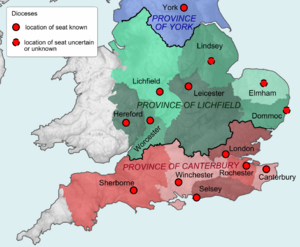
During the English Civil War, the cathedral close (the walled area around the cathedral) was like a fortress. It was attacked three times between 1643 and 1646. Many church leaders supported King Charles I, but most people in the town supported Parliament.
In March 1643, a Parliamentarian leader named Robert Greville was killed during an attack. His deputy, John Gell, then took over and the cathedral surrendered. Later that same year, in April 1643, Prince Rupert led a Royalist army to take Lichfield back. They used an explosive mine to break through the defenses, which was one of the first times this was done in England. The Royalists won this siege.
However, in 1646, the Parliamentarians won again. The cathedral was badly damaged: its central spire was destroyed, the roofs were ruined, and all the stained glass was smashed. Bishop John Hacket started repairing the cathedral in the 1660s with money from the king. But it took until the 1800s for all the war damage to be fully fixed.
Victorian Restoration
The 1700s were a good time for the city of Lichfield, but the cathedral saw many changes. An old library was taken down in 1798, and its books were moved. Most of the statues on the west front were removed, and the stone was covered. Later, James Wyatt made big changes inside, moving the main altar.
The fancy west front was greatly repaired in the Victorian era by George Gilbert Scott. He added many detailed carved figures of kings, queens, and saints. Between 1877 and 1884, new statues were placed in the empty spots on the west front. One statue of Queen Victoria was even carved by her daughter, Princess Louise.
Scott also designed a beautiful metal screen for the choir, made by Francis Skidmore and John Birnie Philip. The colorful Mintons tiles in the choir were inspired by old medieval tiles found during repairs.
The Lichfield Angel
In February 2003, an amazing discovery was made under the nave of the cathedral. It was an 8th-century carved stone panel of the Archangel Gabriel, now known as the Lichfield Angel. This 600mm (about 2 feet) tall panel was found broken into three pieces, but it still had traces of red, black, yellow, and white paint. It is thought to have been part of a stone box that held the remains of Saint Chad.
The colors on the Lichfield Angel are very similar to those in the Lichfield Gospels, which were made around 720-740 AD. The Angel was first shown to the public in 2006, and many more visitors came to the cathedral. After being studied, it is now on display in the cathedral.
COVID-19 Pandemic Response
On January 15, 2021, during the COVID-19 pandemic, Lichfield Cathedral became the first church in England to be used as a place for the COVID-19 vaccination program.
Shrine of St Chad
In November 2022, a new shrine for Saint Chad was dedicated. A relic (a special item connected to the saint) was brought from St Chad's Cathedral, Birmingham to the new shrine in Lichfield.
Cathedral Music
Lichfield Cathedral has a long history of music. Famous organists who have worked here include the 17th-century composer Michael East. Another notable organist was William Henry Harris, who led music at the coronations of King George VI and Queen Elizabeth II.
The cathedral choir has six adult singers called lay vicars choral. In 2021, the number of full-time singers was adjusted. The choir also includes 18 boy choristers and up to 18 girl choristers. There are also scholarships for older students who want to sing in the choir.
Notable Burials
Many important people are buried at Lichfield Cathedral:
- Chad of Mercia (about 634–672) – a saint and early bishop. Some of his remains are now in St Chad's Cathedral, Birmingham.
- Walter Langton (1296–1321) – a powerful Lord High Treasurer of England and Bishop.
- Henry Paget, 1st Marquess of Anglesey (1768–1854) – a cavalry officer who fought in the Battle of Waterloo.
- George Augustus Selwyn (1868–1878) – the first Anglican Bishop of New Zealand.
See also
 In Spanish: Catedral de Lichfield para niños
In Spanish: Catedral de Lichfield para niños
- Architecture of the medieval cathedrals of England
- Bishops of Lichfield
- English Gothic architecture
- Lichfield Cathedral School
- Lichfield Gospels
- List of cathedrals in the United Kingdom
- List of Grade I listed buildings in Staffordshire
- Grade I listed churches in Staffordshire
- Listed buildings in Lichfield
- List of the Bishops of the Diocese of Lichfield and its precursor offices
- Mercian Trail



